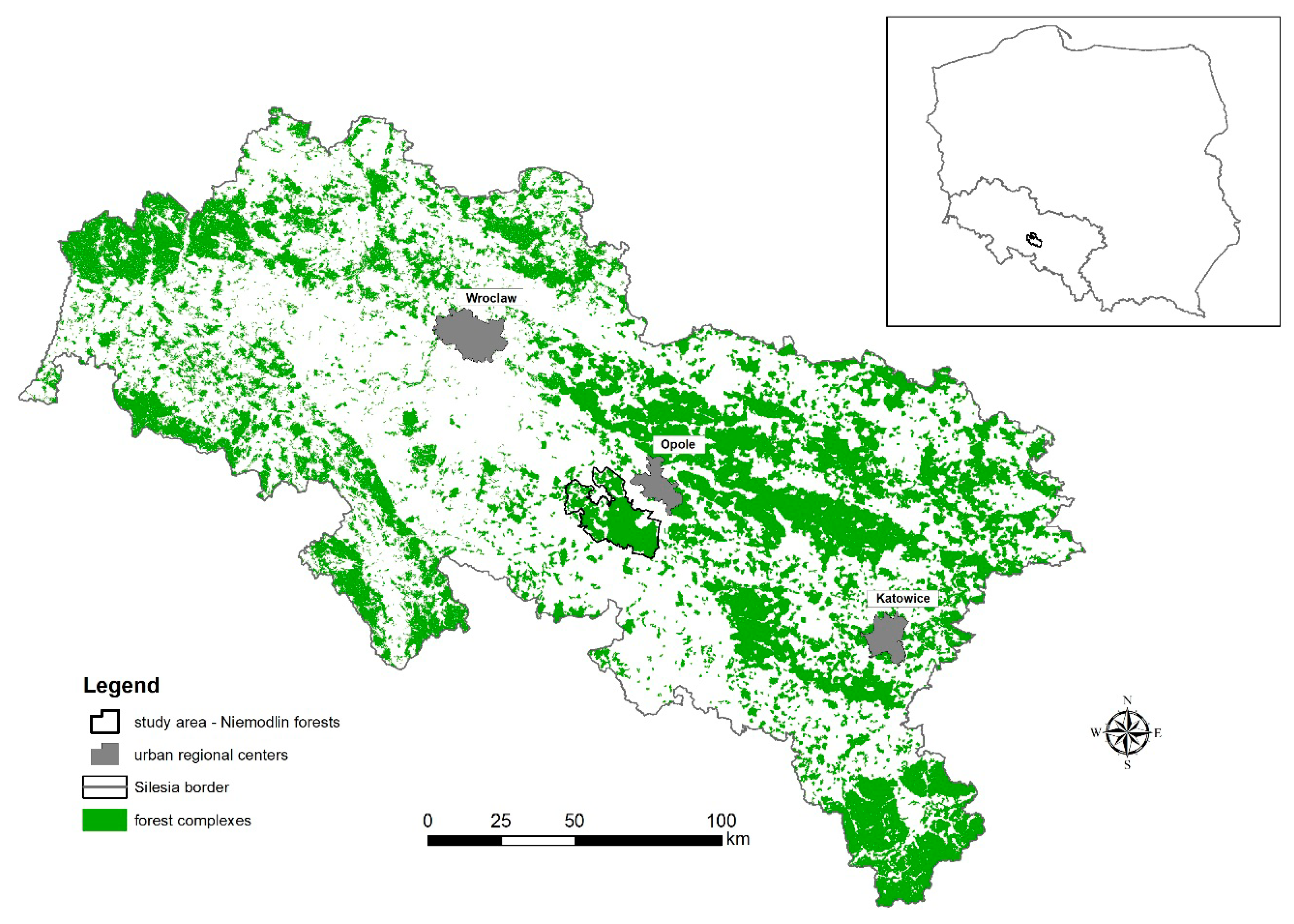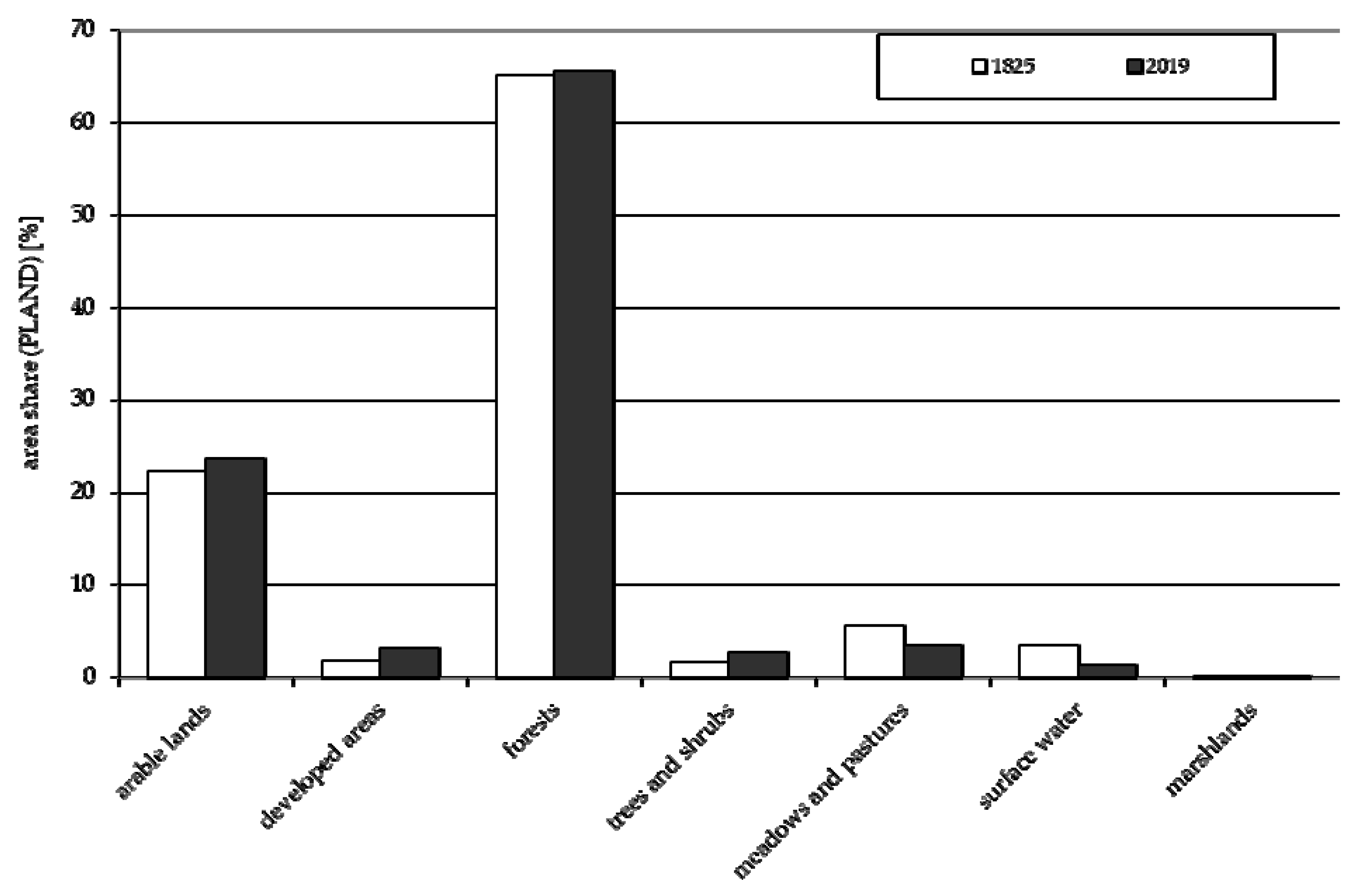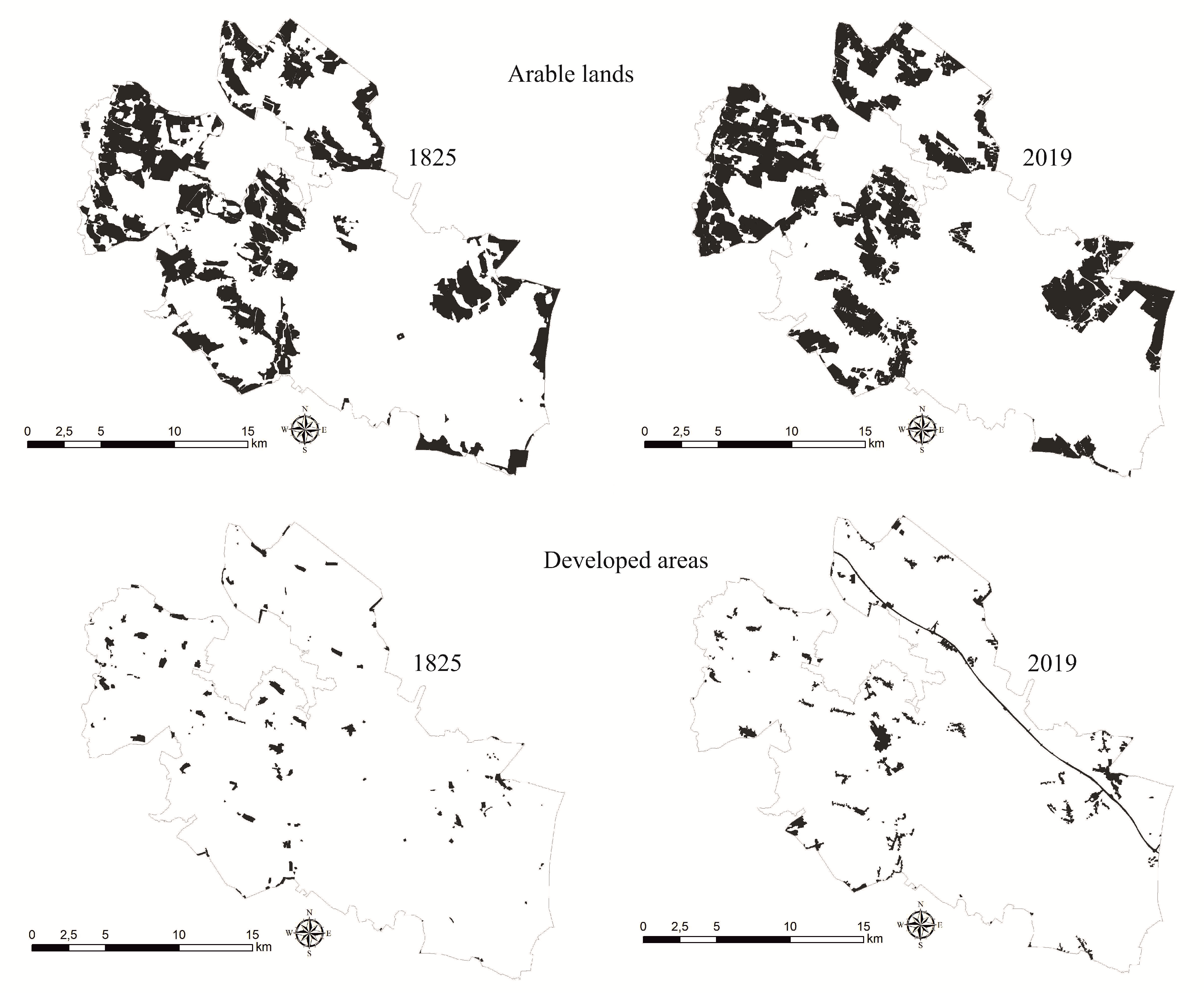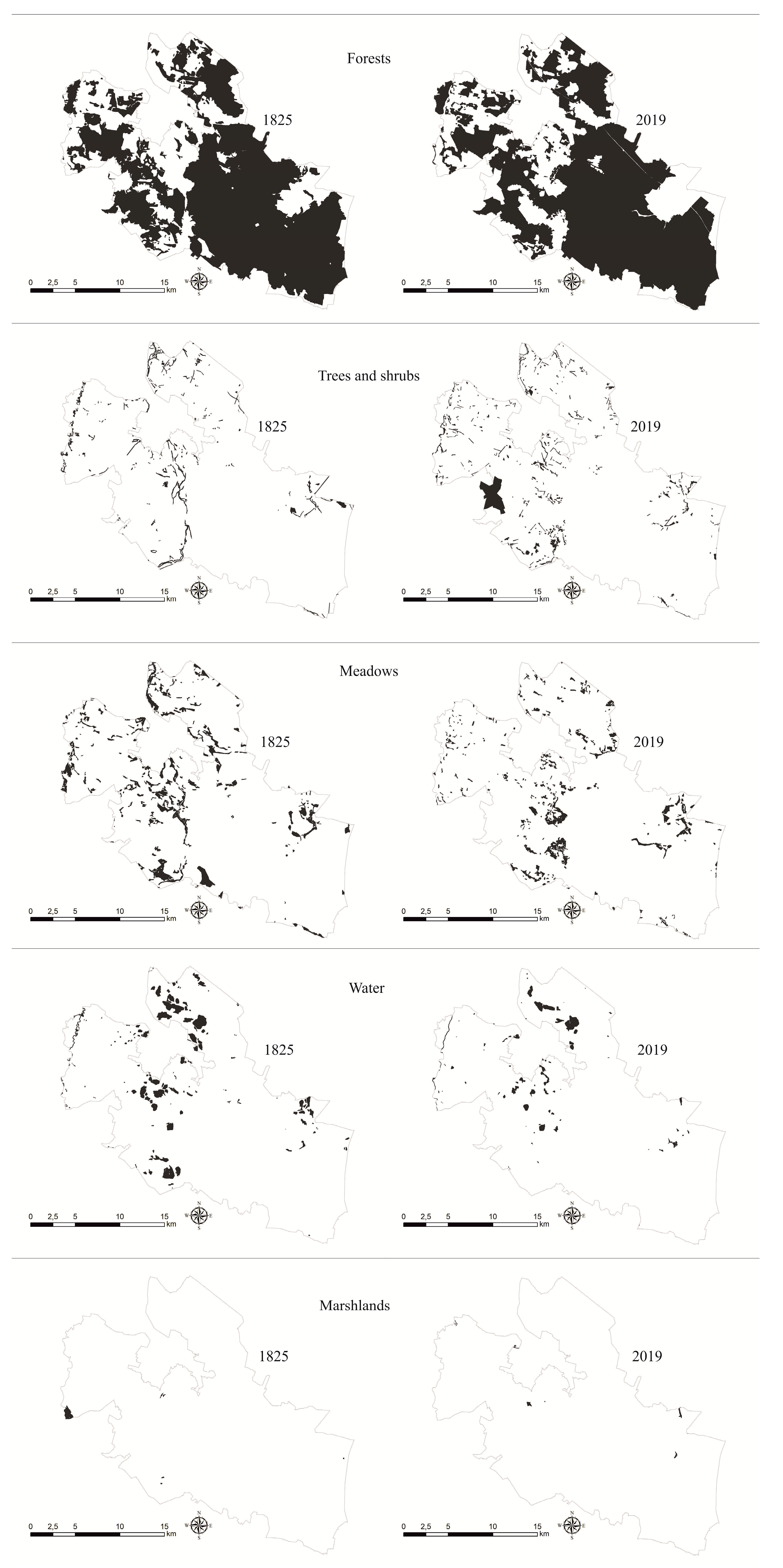Changes in the Spatial Structure of the Landscape of Isolated Forest Complexes in the 19th and 20th Centuries and Their Potential Effects on Supporting Ecosystem Services Related to the Protection of Biodiversity Using the Example of the Niemodlin Forests (SW Poland)
Abstract
1. Introduction
2. Materials and Methods
2.1. Study Area
2.2. Cartographic Data
2.3. Methods
- natural and semi-natural ecosystems: forests, trees and shrubs, surface waters, marshlands, meadows and pastures;
- degraded ecosystems: arable lands;
- devastated ecosystems: developed areas, including road and machine infrastructures.
- forests—areas covered with forest, with an area of over 0,5 ha;
- trees and shrubs—dense areas of roadside and mid-field trees and shrubs with an area of less than 0.5 ha;
- waters—water reservoirs and main watercourses;
- marshlands—wetlands and marshes;
- meadows—meadows and pastures;
- arable lands—land used for agriculture;
- developed areas—building areas, squares, paved areas including road and machine infrastructures.
3. Results and Discussion
3.1. Changes in Surface Shares of Landscape Spatial Structure Elements
3.2. Changes in the Landscape Structure in Spatial Terms
3.3. Changes in the Spatial Composition of the Landscape in Terms of Individual Groups of Escosystems
3.4. Changes in the Spatial Composition of the Landscape
4. Conclusions
Author Contributions
Funding
Conflicts of Interest
References
- Forman, R.T.T.; Godron, M. Patches and Structural Components for A Landscape Ecology. BioScience 1981, 31, 733–740. [Google Scholar] [CrossRef]
- Forman, R.T.T.; Godron, M. Landscape Ecology; J. Wiley & Sons: New York, NY, USA, 1986. [Google Scholar]
- Wu, J. Landscape sustainability science: Ecosystem services and human well-being in changing landscapes. Landsc. Ecol. 2013, 28, 999–1023. [Google Scholar] [CrossRef]
- Franklin, J.F.; Forman, R.T. Creating landscape patterns by forest cutting: Ecological consequences and principles. Landsc. Ecol. 1987, 1, 5–18. [Google Scholar] [CrossRef]
- Lindenmayer, D.B.; Franklin, J.F. Conserving Forest Biodiversity: A Comprehensive Multiscaled Approach; Island Press: Washington, DC, USA, 2002; p. 352. [Google Scholar]
- Riccioli, F.; Marone, E.; Boncinelli, F.; Tattoni, C.; Rocchini, D.; Fratini, R. The recreational value of forests under different management systems. New For. 2018, 1–16. [Google Scholar] [CrossRef]
- Egarter Vigl, L.; Tasser, E.; Schirpke, U.; Tappeiner, U. Using land use/land cover trajectories to uncover ecosystem service patterns across the Alps. Reg. Environ. Chang. 2017. [Google Scholar] [CrossRef]
- Tattoni, C.; Ianni, E.; Geneletti, D.; Zatelli, P.; Ciolli, M. Landscape changes, traditional ecological knowledge and future scenarios in the Alps: A holistic ecological approach. Sci. Total Environ. 2017, 579, 27–36. [Google Scholar] [CrossRef]
- Hobbs, R.J.; Higgs, E.S.; Hall, C.M. Novel Ecosystems: Intervening in the New World Order; Wiley: Oxford, UK, 2013. [Google Scholar]
- Bouma, J.A.; Van Beukering, P.J.H. (Eds.) Ecosystem Services: From Concept to Practice; Cambridge Univeristy Press: Cambridge, UK, 2015. [Google Scholar]
- Potschin, M.; Haines-Young, R.; Fish, R.; Turner, R.K. (Eds.) Routledge Handbook Of Ecosystem Services; Routledge: London, UK, 2016. [Google Scholar]
- Von Haaren, C.; Lovett, A.A.; Albert, C. (Eds.) Landscape Planning with Ecosystem Services. Theories and Methods for Application in Europe; Landscape Series 24; Springer Nature Dordrecht: Berlin/Heidelberg, Germany, 2016. [Google Scholar]
- Grunewald, K.; Bastian, O. Ecosystem Services—Concept, Methods and Case Studies; Springer: Berlin/Heidelberg, Germany, 2015. [Google Scholar]
- Carpenter, S.R.; Pingali, P.; Bennet, E.M.; Zurek, M.B. (Eds.) Millennium Ecosystem Assessment. Ecosystems and Human Well-being: Scenarios. Millennium Ecosystem Assessment; Island Press: Washington, DC, USA, 2005; p. 245. [Google Scholar]
- Hooper, D.U.; Chapin, F.S.; Ewel, J.J.; Hector, A.; Inchausti, P.; Lavorel, S.; Lawton, J.H.; Lodge, D.M.; Loreau, M.; Naeem, S.; et al. Effects of biodiversity on ecosystem functioning: A consensus of current knowledge. Ecol Monog 2005, 75, 3–35. [Google Scholar] [CrossRef]
- Costanza, R.; Fisher, B.; Mulder, K.; Liu, S.; Christopher, T. Biodiversity and ecosystem services: A multi-scale empirical study of the relationship between species rich-ness and net primary production. Ecol. Econ. 2007, 61, 478–491. [Google Scholar] [CrossRef]
- Hector, A.; Bagchi, R. Biodiversity and ecosystem multifunctionality. Nature 2007, 448, 188–190. [Google Scholar] [CrossRef]
- Elmqvist, T.; Maltby, E.; Barker, T.; Mortime, M.; Perrings, C. TEEB, Ecological and Economic Foundation Draft Chapters-Chapter 2: Biodiversity, Ecosystems and Ecosystem Services; UNEP: Geneva, Switzerland, 2010. [Google Scholar]
- Schneiders, A.; Van Daele, T.; Van Landuyt, W.; Van Reeth, W. Biodiversity and ecosystem services: Complementary approaches for ecosystem management? EcolIndic 2012, 21, 123–133. [Google Scholar] [CrossRef]
- Linder, P.; Östlund, L. Structural changes in three mid-boreal Swedish forest landscapes, 1885–1996. Biol. Conserv. 1998, 85, 9–19. [Google Scholar] [CrossRef]
- Rodríguez-Echeverry, J.; Echeverría, C.; Oyarzún, C.; Morales, L. Impact of land-use change on biodiversity and ecosystem services in the Chilean temperate forests. Landsc. Ecol. 2018, 33, 439–453. [Google Scholar] [CrossRef]
- MacDonald, D.; Crabtree, J.R.; Wiesinger, G.; Dax, T.; Stamou, N.; Fleury, P.; Lazpita, J.G.; Gibon, A. Agricultural abandonment in mountain areas of Europe: Environmental consequences and policy response. J. Environ. Manag. 2000, 59, 47–69. [Google Scholar] [CrossRef]
- Ciolli, M.; Tattoni, C.; Ferretti, F. Understanding forest changes to support planning: A fine-scale Markov chain approach. In Developments in Environmental Modelling; Elsevier: Amsterdam, The Netherlands, 2012; pp. 355–373. [Google Scholar] [CrossRef]
- Carpenter, S.; Mooney, H.; Agard, J.; Capistrano, D.; Defries, R.S.; Díaz, S.; Dietz, T.; Duraiappah, A.K.; Oteng-Yeboah, A.; Pereira, H.M.; et al. Science for managing ecosystem services: Beyond the millennium ecosystem assessment. Proc. Natl. Acad. Sci. USA 2009, 106, 1305–1312. [Google Scholar] [CrossRef]
- Iverson, L.; Echeverria, C.; Nahuelhual, L.; Luque, S. Ecosystem services in changing landscapes: An introduction. Lands Ecol. 2014, 29, 181–186. [Google Scholar] [CrossRef]
- McGarigal, K.; Cushman, S.A.; Ene, E. FRAGSTATS v4: Spatial Pattern Analysis Program for Categorical and Continuous Maps. Computer Software Program Produced by the Authors at the University of Massachusetts, Amherst. 2012. Available online: http://www.umass.edu/landeco/research/fragstats/fragstats.html (accessed on 23 March 2020).
- Syrbe, R.U.; Walz, U. Spatial indicators for the assessment of ecosystem services: Providing, benefiting and connecting areas and landscape metrics. Ecol. Indic. 2012, 21, 80–88. [Google Scholar] [CrossRef]
- Waltz, U. Landscape Structure, Landscape Metrics and Biodiversity. Living Rev. Landsc. Res. 2011, 5, 1–35. [Google Scholar] [CrossRef]
- Marshall, E.; Wintle, B.A.; Southwell, D.; Kujala, H. What are we measuring? A review of metrics used to describe biodiversity in offsets exchanges. Biol. Conserv. 2020, 241, 1–8. [Google Scholar] [CrossRef]
- Dittrich, A.; Wehrden, H.; Abson, D.J.; Bartkowski, B.; Cord, A.; Fust, P.; Hoyer, C.; Kambach, S.; Meyer, M.A.; Radzeviciute, R.; et al. Mapping and analysing historical indicators of ecosystem services in Germany. Ecol. Indic. 2017, 75, 101–110. [Google Scholar] [CrossRef]
- Niemandt, C.; Greve, M. Fragmentation metric proxies provide insights into historical biodiversity loss in critically endangered grassland. Agric. Ecosyst. Environ. 2016, 235, 172–181. [Google Scholar] [CrossRef]
- Morelli, F.; Jiguet, F.; Sabatier, R.; Dross, C.; KarinePrince, K.; Tryjanowski, P.; Tichit, M. Spatial covariance between ecosystem services and biodiversity pattern at a national scale (France). Ecol. Indic. 2017, 82, 574–586. [Google Scholar] [CrossRef]
- Herzog, F.; Lausch, A.; Müller, E.; Thulke, H.H.; Steinhardt, U.; Lehmann, S. Landscape metrics for assessment of landscape destruction and rehabilitation. Environ. Manag. 2001, 27, 91–107. [Google Scholar] [CrossRef]
- Frank, S.; Fürst, C.; Koschke, L.; Makeschin, F. A contribution towards a transfer of the ecosystem service concept to landscape planning using landscape metrics. Ecol. Indic. 2012, 21, 30–38. [Google Scholar] [CrossRef]
- Almeida, D.; Rocha, J.; Neto, C.; Arsenio, P. Landscape metrics applied to formerly reclaimed saltmarshes: A tool to evaluate ecosystem services? Estuar. Coast. Shelf Sci. 2016, 181, 100–113. [Google Scholar] [CrossRef]
- Lamy, T.; Liss, K.N.; Gonzales, A.; Bennett, E.M. Landscape structure affects the provision of multiple ecosystem services. Environ. Res. Lett. 2016, 11, 124017. Available online: http://iopscience.iop.org/1748-9326/11/12/124017 (accessed on 23 March 2020). [CrossRef]
- Duarte, G.T.; Santos, P.M.; Cornelissen, T.G.; Ribeiro, M.C.; Paglia, A.P. The effects of landscape patterns on ecosystem services: Meta-analyses of landscape services. Landsc. Ecol. 2018, 33, 1247–1257. [Google Scholar] [CrossRef]
- Hooftman, D.A.P.; Bullock, J.M. Mapping to inform conservation: A case study of changes in semi-natural habitats and their connectivity over 70 years. Biol. Conserv. 2012, 145, 30–38. [Google Scholar] [CrossRef]
- Liu, S.; Dong, Y.; Deng, L.; Liu, L.; Zhao, H.; Dong, S. Forest fragmentation and landscape connectivity change associated with road network extension and city expansion: A case study in the Lancang River Valley. Ecol. Indic. 2014, 36, 160–168. [Google Scholar] [CrossRef]
- Ren, Z.; Peng, H.; Liu, Z.W. The rapid climate change-caused dichotomy on subtropical evergreen broad-leaved forest in Yunnan: Reduction in habitat diversity and increase in species diversity. Plant Divers 2016, 38, 142–148. [Google Scholar] [CrossRef]
- Chan, K.M.A.; Shaw, M.R.; Cameron, D.R.; Underwood, E.C.; Daily, G.C. Conservation planning for ecosystem services. Public Libr. Sci. Biol. 2006, 4, e379. [Google Scholar] [CrossRef]
- Solon, J.; Borzyszkowski, J.; Bidłasik, M.; Richling, A.; Badora, K.; Balon, J.; Brzezińska-Wójcik, T.; Chabudziński, Ł.; Dobrowolski, R.; Grzegorczyk, I.; et al. Physico-geographical mesoregions of Poland: Verification and adjustment of boundaries on the basis of contemporary spatial data. Geogr. Pol. 2018, 91, 143–170. [Google Scholar] [CrossRef]
- Jędrzejewski, W.; Nowak, S.; Stachura, K.; Skierczyński, M.; Mysłajek, R.W.; Niedziałkowski, K.; Jędrzejewska, B.; Wójcik, J.M.; Zalewska, H.; Pilot, M.; et al. Projekt Korytarzy Ekologicznych Łączących Europejską Sieć Natura 2000 w Polsce; Zakład Badania Ssaków PAN: Białowieża, Poland, 2011. [Google Scholar]
- Konias, A. Kartografia topograficzna państwa i zaboru pruskiego od II połowy XVIII wieku do połowy XX wieku; Wydawnictwo Naukowe Akademii Pomorskiej w Słupsku: Słupsk, Poland, 2010; p. 232. [Google Scholar]
- Lorek, D. Potencjał informacyjny map topograficznych z lat 1822-33 (Urmesstischblätter) z terenu Wielkopolski, praca doktorska, maszynopis; Uniwersytet Adama Mickiewicza w Poznaniu: Poznań, Poland, 2011. [Google Scholar]
- Urbański, J. GIS w badaniach przyrodniczych; Wydawnictwo Uniwersytetu Gdańskiego: Gdańsk, Poland, 2008; p. 252. [Google Scholar]
- Goodchild, M.; Gopal, S. (Eds.) Accuracy of Spatial Databases; Taylor and Francis: London, UK, 1989; p. 308. [Google Scholar]
- Kraak, M.J.; Ormeling, F. Cartography: Visualization of Spatial Data; Routledge: London, UK, 2013; p. 204. [Google Scholar]
- Van Der Zee, D. GIS and landscape change analysis. In GIS i teledetekcja w badaniach struktury i funkcjonowania krajobrazu; Nienartowicz, A., Kunz, M., Eds.; UMK: Toruń, Poland, 2001; pp. 27–38. [Google Scholar]
- Pontius, J.R. Quantification error versus location error in the comparison of categorical maps. Photogramm. Eng. Remote Sens. 2000, 66, 1011–1016. [Google Scholar]
- Hagen, A. Fuzzy set approach to assessing similarity of categorical maps. Int. J. Geogr. Inf. Sci. 2003, 17, 235–249. [Google Scholar] [CrossRef]
- Gobbi, S.; Ciolli, M.; La Porta, N.; Rocchini, D.; Tattoni, C.; Zatelli, P. New Tools for the Classification and Filtering of Historical Maps. ISPRS Int. J. Geo-Information 2019, 8, 455. [Google Scholar] [CrossRef]
- Butchart, S.H.M.; Walpole, M.; Collen, B.; van Strien, A.; Scharlemann, J.P.W.; Almond, R.A.E.; Baillie, J.E.M.; Bomhard, B.; Brown, C.; Bruno, J.; et al. Global biodiversity: Indicators of recent declines. Science 2010, 328, 1164–1168. [Google Scholar] [CrossRef]
- Lindenmayer, D. Land use intensification in natural forest settings. In Land Use Intensification: Effects on Agriculture, Biodiversity and Ecological Processes; Lindenmayer, D., Cunningham, S., Young, A., Eds.; CSIRO Publishing: Clayton, Australia, 2012; pp. 113–121. [Google Scholar] [CrossRef]
- Lindenmayer, D. Interactions between forest resource management and landscape structure. Curr. Lands Ecol. Rep. 2016, 1, 10–18. [Google Scholar] [CrossRef]
- Vihervaara, P.; Rönkä, M.; Walls, M. Trends in ecosystem service research: Early steps and current drivers. AMBIOA J. Hum. Environ. 2010, 39, 314–324. [Google Scholar] [CrossRef]
- Pan, Y.; Xu, Z.; Wu, J. Spatial differences of the supply of multiple ecosystem services and the environmental and land use factors affecting them. Ecosyst. Serv. 2013, 5, 4–10. [Google Scholar] [CrossRef]
- Bai, Y.; Zhuang, C.; Ouyang, Z.; Zheng, H.; Jiang, B. Spatial characteristics between biodiversity and ecosystem services in a human-dominated watershed. Ecol. Complex 2011, 8, 177–183. [Google Scholar] [CrossRef]
- Krajewski, P.; Solecka, I.; Mrozik, K. Forest Landscape Change and Preliminary Study on Its Driving Forces in Ślęża Landscape Park (Southwestern Poland) in 1883–2013. Sustainability 2018, 10, 4526. [Google Scholar] [CrossRef]
- Szymura, T.H.; Murak, S.; Szymura, M.; Raduła, M.W. Changes in forest cover in Sudety Mountains during the last 250 years: Patterns, drivers, and landscape-scale implications for nature conservation. Acta Soc. Bot. Pol. 2018, 87, 1–14. [Google Scholar] [CrossRef]
- Sobala, M.; Rahmonov, O.; Myga-Piątek, U. Historical and contemporary forest ecosystem changes in the Beskid Mountains (southern Poland) between 1848 and 2014. iForest Biogeosci. For. 2017, 10, 939–947. [Google Scholar] [CrossRef]
- Kozak, J. Forest cover change in the Western Carpathians in the past 180 years: A case study in the Orawa region in Poland. Mt. Res. Dev. 2003, 23, 369–375. [Google Scholar] [CrossRef]
- Szabo, P. Driving forces of stability and change in woodland structure: A case-study from the Czech lowlands. For. Ecol. Manag. 2010, 259, 650–656. [Google Scholar] [CrossRef]
- Plieninger, T.; Draux, H.; Fagerholm, N.; Bieling, C.; Bürgi, M.; Kizos, T.; Kuemmerle, T.; Primdahl, J.; Verburg, P.H. The driving forces of landscape change in Europe: A systematic review of the evidence. Land Use Policy 2016, 57, 204–214. [Google Scholar] [CrossRef]
- Krajewski, P. Monitoring of Landscape Transformations within Landscape Parks in Poland in the 21st Century. Sustainability 2019, 11, 2410. [Google Scholar] [CrossRef]
- Kark, S. Effects of Ecotones on Biodiversity. In Reference Module in Life Sciences; Elsevier: Amsterdam, The Netherlands, 2017. [Google Scholar] [CrossRef]
- Ferrier, S.; Drielsma, M.J. Synthesis of pattern and process in biodiversity conservation assessment: A flexible whole-landscape modelling framework. Divers. Distrib. 2010, 16, 386–402. [Google Scholar] [CrossRef]
- Southworth, J.; Nagendra, H.; Tucker, C. Fragmentation of a landscape: Incorporating landscape metrics into satellite analyses of land-cover change. Landsc. Res. 2002, 27, 253–269. [Google Scholar] [CrossRef]




| Sheet | Symbol (Sheet Number) | The Year of Publication | Source |
|---|---|---|---|
| Bösdorf | 3194 | 1825 | National Library of Berlin |
| Dambrau | 3141 | 1825 | National Library of Berlin |
| Falkenberg | 3140 | 1825 | National Library of Berlin |
| Grottkau | 3139 | 1825 | National Library of Berlin |
| Krappitz | 3252 | 1825 | National Library of Berlin |
| Löwen | 3081 | 1825 | National Library of Berlin |
| Oppeln | 3142 | 1825 | National Library of Berlin |
| Proskau | 3197 | 1825 | National Library of Berlin |
| Psychod | 3196 | 1825 | National Library of Berlin |
| Schelitz | 3251 | 1825 | National Library of Berlin |
| Schurgast | 3082 | 1825 | National Library of Berlin |
| Tillowitz | 3195 | 1825 | National Library of Berlin |
| Landscape Structure Index | Arable Lands | Developed Areas | ||
|---|---|---|---|---|
| 1825 | 2019 | 1825 | 2019 | |
| CA | 11,284.8 | 11,976.1 | 901.2 | 1573.1 |
| PLAND | 22.3 | 23.7 | 1.8 | 3.1 |
| NP | 193.0 | 210.0 | 156.0 | 233.0 |
| PD | 0.4 | 0.4 | 0.3 | 0.5 |
| LPI | 4.2 | 3.3 | 0.1 | 0.6 |
| AREA_MN | 58.5 | 57.0 | 5.8 | 6.8 |
| GYRATE_MN | 243.0 | 225.6 | 92.8 | 122.0 |
| PARA_MN | 417.1 | 399.0 | 520.4 | 672.5 |
| CONTIG_MN | 0.9 | 0.9 | 0.9 | 0.8 |
| CONNECT | 0.5 | 0.6 | 0.1 | 0.2 |
| DIVISION | 1.0 | 1.0 | 1.0 | 1.0 |
| MESH | 145.9 | 122.7 | 0.3 | 2.7 |
| SPLIT | 346.7 | 412.0 | 156,725.1 | 18,627.0 |
| Landscape Structure Index | Forests | Trees and Shrubs | Meadows | Water | Marshlands | |||||
|---|---|---|---|---|---|---|---|---|---|---|
| 1825 | 2019 | 1825 | 2019 | 1825 | 2019 | 1825 | 2019 | 1825 | 2019 | |
| CA | 32,876.9 | 33,165.9 | 806.0 | 1366.6 | 2807.7 | 1694.1 | 1793.2 | 724.1 | 92.9 | 44.2 |
| PLAND | 65.0 | 65.6 | 1.6 | 2.7 | 5.6 | 3.4 | 3.5 | 1.4 | 0.2 | 0.1 |
| NP | 65.0 | 67.0 | 251.0 | 469.0 | 298.0 | 356.0 | 172.0 | 107.0 | 6.0 | 9.0 |
| PD | 0.1 | 0.1 | 0.5 | 0.9 | 0.6 | 0.7 | 0.3 | 0.2 | 0.0 | 0.0 |
| LPI | 43.6 | 52.2 | 0.1 | 1.2 | 0.4 | 0.4 | 0.3 | 0.3 | 0.2 | 0.0 |
| AREA_MN | 505.8 | 495.0 | 3.2 | 2.9 | 9.4 | 4.8 | 10.4 | 6.8 | 15.5 | 4.9 |
| GYRATE_MN | 442.1 | 386.4 | 106.4 | 73.9 | 137.9 | 88.0 | 107.2 | 92.8 | 124.8 | 113.0 |
| PARA_MN | 327.3 | 436.0 | 884.1 | 1208.9 | 564.9 | 661.3 | 568.5 | 675.6 | 385.6 | 831.3 |
| CONTIG_MN | 0.9 | 0.9 | 0.8 | 0.7 | 0.8 | 0.8 | 0.8 | 0.8 | 0.9 | 0.8 |
| CONNECT | 0.5 | 0.7 | 0.1 | 0.1 | 0.2 | 0.1 | 0.2 | 0.5 | 0.0 | 2.8 |
| DIVISION | 0.8 | 0.7 | 1.0 | 1.0 | 1.0 | 1.0 | 1.0 | 1.0 | 1.0 | 1.0 |
| MESH | 10,093.7 | 13,871.9 | 0.3 | 7.6 | 3.0 | 1.7 | 2.1 | 0.7 | 0.1 | 0.0 |
| SPLIT | 5.0 | 3.6 | 165,065.2 | 6689.6 | 16,848.0 | 29,463.9 | 23,931.6 | 68,614.8 | 373,839.6 | 4,826,586.9 |
| Landscape Structure Index | 1825 | 2019 |
|---|---|---|
| TA | 50,562.86 | 50,544.02 |
| PD | 2.26 | 2.81 |
| TE | 1,445,560.00 | 1,502,490.00 |
| ED | 28.59 | 30.28 |
| AREA_MN | 44.31 | 34,83 |
| GYRATE_MN | 155.21 | 123.10 |
| PARA_MN | 590.10 | 793.84 |
| CONTIG_MN | 0.84 | 0.78 |
| PAFRAC | 1.28 | 1.29 |
| CWED | 14.24 | 15.24 |
| TECI | 38.30 | 39.60 |
| CONNECT | 0.20 | 0.18 |
| DIVISION | 0.80 | 0.72 |
| MESH | 10,245.39 | 14,007.35 |
| SPLIT | 4.94 | 3.61 |
| SHDI | 1.04 | 1.00 |
| SHEI | 0.54 | 0.52 |
© 2020 by the authors. Licensee MDPI, Basel, Switzerland. This article is an open access article distributed under the terms and conditions of the Creative Commons Attribution (CC BY) license (http://creativecommons.org/licenses/by/4.0/).
Share and Cite
Badora, K.; Wróbel, R. Changes in the Spatial Structure of the Landscape of Isolated Forest Complexes in the 19th and 20th Centuries and Their Potential Effects on Supporting Ecosystem Services Related to the Protection of Biodiversity Using the Example of the Niemodlin Forests (SW Poland). Sustainability 2020, 12, 4237. https://doi.org/10.3390/su12104237
Badora K, Wróbel R. Changes in the Spatial Structure of the Landscape of Isolated Forest Complexes in the 19th and 20th Centuries and Their Potential Effects on Supporting Ecosystem Services Related to the Protection of Biodiversity Using the Example of the Niemodlin Forests (SW Poland). Sustainability. 2020; 12(10):4237. https://doi.org/10.3390/su12104237
Chicago/Turabian StyleBadora, Krzysztof, and Radosław Wróbel. 2020. "Changes in the Spatial Structure of the Landscape of Isolated Forest Complexes in the 19th and 20th Centuries and Their Potential Effects on Supporting Ecosystem Services Related to the Protection of Biodiversity Using the Example of the Niemodlin Forests (SW Poland)" Sustainability 12, no. 10: 4237. https://doi.org/10.3390/su12104237
APA StyleBadora, K., & Wróbel, R. (2020). Changes in the Spatial Structure of the Landscape of Isolated Forest Complexes in the 19th and 20th Centuries and Their Potential Effects on Supporting Ecosystem Services Related to the Protection of Biodiversity Using the Example of the Niemodlin Forests (SW Poland). Sustainability, 12(10), 4237. https://doi.org/10.3390/su12104237





